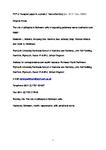The role of p38alpha in Schwann cells in regulating peripheral nerve myelination and repair
| dc.contributor.author | Roberts, SL | |
| dc.contributor.author | Zhang, He | |
| dc.contributor.author | Dee, G | |
| dc.contributor.author | Gray, B | |
| dc.contributor.author | Mindos, T | |
| dc.contributor.author | Parkinson, David | |
| dc.date.accessioned | 2017-01-03T15:31:11Z | |
| dc.date.available | 2017-01-03T15:31:11Z | |
| dc.date.issued | 2017-01-13 | |
| dc.identifier.issn | 0022-3042 | |
| dc.identifier.issn | 1471-4159 | |
| dc.identifier.uri | http://hdl.handle.net/10026.1/8176 | |
| dc.description.abstract |
<jats:title>Abstract</jats:title><jats:sec><jats:label /><jats:p>Myelination in the peripheral nervous system (<jats:styled-content style="fixed-case">PNS</jats:styled-content>) is controlled by both positive and negative regulators within Schwann cells to ensure timely onset and correct myelin thickness for saltatory conduction by neurons. Transcription factors such as Sox10, octamer‐binding transcription factor 6 (Oct6) and Krox20 form a positive regulatory network, whereas negative regulators such as <jats:styled-content style="fixed-case">cJ</jats:styled-content>un and Sox2 oppose myelination in Schwann cells. The role of the p38 <jats:styled-content style="fixed-case">MAPK</jats:styled-content> pathway has been studied in <jats:styled-content style="fixed-case">PNS</jats:styled-content> myelination, but its precise function remains unclear, with both positive and negative effects of p38 activity reported upon both myelination and processes of nerve repair. To clarify the role of p38 <jats:styled-content style="fixed-case">MAPK</jats:styled-content> in the <jats:styled-content style="fixed-case">PNS</jats:styled-content>, we have analysed mice with a Schwann cell‐specific ablation of the major p38 isoform, p38alpha. In line with previous findings of an inhibitory role for p38 <jats:styled-content style="fixed-case">MAPK</jats:styled-content>, we observe acceleration of post‐natal myelination in p38alpha null nerves, a delay in myelin down‐regulation following injury, together with a small increase in levels of re‐myelination following injury. Finally we explored roles for p38alpha in controlling axonal regeneration and functional repair following <jats:styled-content style="fixed-case">PNS</jats:styled-content> injury and observe that loss of p38alpha function in Schwann cells does not appear to affect these processes as previously reported. These studies therefore provide further proof for a role of p38 <jats:styled-content style="fixed-case">MAPK</jats:styled-content> signalling in the control of myelination by Schwann cells in the <jats:styled-content style="fixed-case">PNS</jats:styled-content>, but do not show an apparent role for signalling by this <jats:styled-content style="fixed-case">MAP</jats:styled-content> kinase in Schwann cells controlling other elements of Wallerian degeneration and functional repair following injury.</jats:p></jats:sec><jats:sec><jats:label /><jats:p> <jats:boxed-text content-type="graphic" position="anchor"><jats:graphic xmlns:xlink="http://www.w3.org/1999/xlink" mimetype="image/png" position="anchor" specific-use="enlarged-web-image" xlink:href="graphic/jnc13929-fig-0007-m.png"><jats:alt-text>image</jats:alt-text></jats:graphic></jats:boxed-text> </jats:p><jats:p><jats:bold>Cover Image</jats:bold> for this issue: doi: <jats:ext-link xmlns:xlink="http://www.w3.org/1999/xlink" ext-link-type="doi" xlink:href="10.1111/jnc.13793">10.1111/jnc.13793</jats:ext-link>.</jats:p></jats:sec> | |
| dc.format.extent | 37-47 | |
| dc.format.medium | Print-Electronic | |
| dc.language | en | |
| dc.language.iso | en | |
| dc.publisher | Wiley | |
| dc.subject | myelin | |
| dc.subject | p38 | |
| dc.subject | peripheral nerve | |
| dc.subject | regeneration | |
| dc.subject | Schwann | |
| dc.title | The role of p38alpha in Schwann cells in regulating peripheral nerve myelination and repair | |
| dc.type | journal-article | |
| dc.type | Journal Article | |
| dc.type | Research Support, Non-U.S. Gov't | |
| plymouth.author-url | https://www.webofscience.com/api/gateway?GWVersion=2&SrcApp=PARTNER_APP&SrcAuth=LinksAMR&KeyUT=WOS:000397502400004&DestLinkType=FullRecord&DestApp=ALL_WOS&UsrCustomerID=11bb513d99f797142bcfeffcc58ea008 | |
| plymouth.issue | 1 | |
| plymouth.volume | 141 | |
| plymouth.publication-status | Published | |
| plymouth.journal | Journal of Neurochemistry | |
| dc.identifier.doi | 10.1111/jnc.13929 | |
| plymouth.organisational-group | /Plymouth | |
| plymouth.organisational-group | /Plymouth/Faculty of Health | |
| plymouth.organisational-group | /Plymouth/Faculty of Health/Peninsula Medical School | |
| plymouth.organisational-group | /Plymouth/REF 2021 Researchers by UoA | |
| plymouth.organisational-group | /Plymouth/REF 2021 Researchers by UoA/UoA01 Clinical Medicine | |
| plymouth.organisational-group | /Plymouth/REF 2021 Researchers by UoA/UoA03 Allied Health Professions, Dentistry, Nursing and Pharmacy | |
| plymouth.organisational-group | /Plymouth/Research Groups | |
| plymouth.organisational-group | /Plymouth/Research Groups/Institute of Translational and Stratified Medicine (ITSMED) | |
| plymouth.organisational-group | /Plymouth/Research Groups/Institute of Translational and Stratified Medicine (ITSMED)/CBR | |
| plymouth.organisational-group | /Plymouth/Users by role | |
| plymouth.organisational-group | /Plymouth/Users by role/Academics | |
| plymouth.organisational-group | /Plymouth/Users by role/Researchers in ResearchFish submission | |
| dc.publisher.place | England | |
| dcterms.dateAccepted | 2016-11-29 | |
| dc.rights.embargodate | 2018-1-13 | |
| dc.identifier.eissn | 1471-4159 | |
| dc.rights.embargoperiod | Not known | |
| rioxxterms.versionofrecord | 10.1111/jnc.13929 | |
| rioxxterms.licenseref.uri | http://www.rioxx.net/licenses/all-rights-reserved | |
| rioxxterms.licenseref.startdate | 2017-01-13 | |
| rioxxterms.type | Journal Article/Review |


